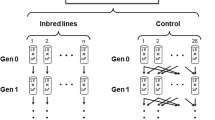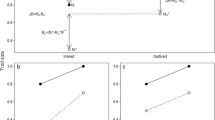Summary
The aim of the experiment was to determine if the estimated genetic distance between two populations could be used to predict the amount of heterosis that would occur when they were crossed. Eight lines of known relatedness to each other were produced by eight generations of sib mating and sub-lining. This produced lines that varied in coefficient of coancestry from zero to 0.78. Fourteen reciprocal crosses of these lines were used to measure heterosis for larval viability and adult fecundity. Gene frequencies at six polymorphic enzyme loci were used to estimate the genetic distances between lines, which were then compared with the known degrees of coancestry. The estimated genetic differences were poorly correlated with the known coancestry coefficients (r=0.4), possibly due to the small number of loci typed. Also genetic distances were only about 1/3 of what was expected. Selection acting on blocks of genes linked to the enzyme loci probably prevented the expected increase in homozygosity. Coancestry coefficient was correlated with heterosis (r=0.44–0.71). This level of correlation implied differences in heterosis among parent lines with the same level of coancestry. This variability is expected if a small number of loci explain most of the heterosis. The average level of heterosis was less than expected after eight generations of sib mating. This is most likely due to selection opposing the increase in homozygosity caused by inbreeding. The combination of these two imperfect correlations resulted in no significant correlation between genetic distance estimated from markers and heterosis.
Similar content being viewed by others
References
Ehiobu NG (1985) The prediction of heterosis. PhD thesis James Cook University, Townsville, Australia, pp 61–62
Ehiobu NG, Goddard ME (1990) Heterosis in crosses between geographically separated populations of Drosophila melanogaster. Theor Appl Genet (in press)
Ehiobu NG, Goddard ME, Taylor JF (1989) Effect of rate of inbreeding on inbreeding depression of Drosophila melanogaster. Theor Appl Genet 77:123–127
Glodek P (1974) Specific problems of breed evaluation and crossing in pigs. In: Proc Working Symp Breed Evaluation and Crossing Experiments with Farm Animals. Schoonerd, Zeist: Research Institute of Animal Husbandry, Zeist, pp 267
Goddard ME, Ahmed AM (1982) The use of genetic distance between cattle breeds to predict the heterosis in crosses. In: Proc 2nd World Congr Genet Appl Livestock Prod, Madrid, Spain, pp 377–382
Robertson FW, Reeve ECE (1955) Studies in quantitative genetics. VIII. Further analyses of heterosis in crosses between inbred lines of Drosophila melanogaster. Z. Indukt Abstamm Vererbungsl 86:439–458
Rumball W (1974) The decrease in heterozygosity produced by close inbreeding. Part of PhD thesis, Macquarie University, Sydney
Sved JA (1975) Fitness of third chromosome homozygotes in Drosophila melanogaster. Genet Res 25:197–200
Author information
Authors and Affiliations
Additional information
Communicated by J. S. F. Barker
Rights and permissions
About this article
Cite this article
Ehiobu, N.G., Goddard, M.E. & Taylor, J.F. Prediction of heterosis in crosses between inbred lines of Drosophila melanogaster . Theoret. Appl. Genetics 80, 321–325 (1990). https://doi.org/10.1007/BF00210066
Received:
Accepted:
Issue Date:
DOI: https://doi.org/10.1007/BF00210066




